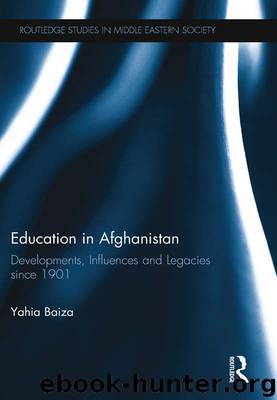Education in Afghanistan by Baiza Yahia

Author:Baiza, Yahia
Language: eng
Format: epub
ISBN: 9781134120895
Publisher: Taylor & Francis (CAM)
Political developments in education
Throughout the 1980s, education remained an attractive political tool in the hands of both the PDPA and the resistance parties. The PDPA's factions, Khalq and Parcham, both had a tradition of propagating their ideologies through the educational institutions. As has already been discussed, they were particularly active in teacher training institutes and secondary and tertiary educational institutions long before emerging to power in 1978. From the PDPA's point of view, using education as a political platform might have been the continuation of its political tradition, something to be encouraged rather than condemned. Therefore, the ruling authorities in Kabul viewed education as a mechanism for the achievement of the party's political goals. In 1981, the government underlined that:
Fundamental changes in the field of education are an important part of the wider process of changes that are brought about by the national and democratic revolution in the country. Education has a strong and determining influence in the acceleration and triumph of a cultural and ideological revolution; creation of suitable environments for the actualization of scientific and technological breakthroughs; growth and development of productive forces; and establishment and development of new social relations.
(Andishmand 2008)
As indicated by the party's statement above, the government used the curriculum, textbooks and educational institutions to strengthen its political base. Building upon the tradition of using education as a political platform, the PDPA used social science textbooks as the primary channels through which to transmit political messages to students. These textbooks spoke about: political history and the economic structure of social classes; class struggles; theories of social revolution; the global revolutionary movements; socialism; the worldwide crisis of the capitalist system; the international labour movements; the national liberation movements; and the scientific worldview of the labouring class (Mirzazadah et al. 1990: 24–5). Also it was believed that the new history textbooks were rewritten in the USSR. These replaced the former textbooks that were written and printed in Afghanistan (Girardet 1985: 145–51). History textbooks also dealt with issues such as: freedom and independence; struggle against the British occupation; the Great October Revolution and its influence on developments in Eastern countries, particularly in Afghanistan; the history of mutual friendship between Afghanistan and the Soviet Union; the conspiracies of national and international elements against Afghanistan's independence and its geographical integrity; and the historical event of the April Revolution in Afghanistan and the national reconciliation policy (Mirzazadah et al. 1990: 25). A similar process was also underway in the institutions of higher education, where subjects like historical materialism, the history of revolutionary movements, scientific sociology, dialectical materialism, political economy and the contemporary history of Afghanistan gained prominence (Girardet 1985: 145; Majrooh 1988: 86; Andishmand 2008). The use of education as a political and ideological mechanism was not unique to the PDPA. It has been happening in other countries, in the previous eras in Afghanistan as well as under the resistance parties outside and inside Afghanistan. States have always been looking to the education system to influence the mind of new generations.
However,
Download
This site does not store any files on its server. We only index and link to content provided by other sites. Please contact the content providers to delete copyright contents if any and email us, we'll remove relevant links or contents immediately.
The Art of Coaching Workbook by Elena Aguilar(50984)
Trainspotting by Irvine Welsh(21518)
Twilight of the Idols With the Antichrist and Ecce Homo by Friedrich Nietzsche(18501)
Fangirl by Rainbow Rowell(9095)
Periodization Training for Sports by Tudor Bompa(8170)
Change Your Questions, Change Your Life by Marilee Adams(7635)
This Is How You Lose Her by Junot Diaz(6794)
Asking the Right Questions: A Guide to Critical Thinking by M. Neil Browne & Stuart M. Keeley(5632)
Grit by Angela Duckworth(5521)
Red Sparrow by Jason Matthews(5390)
Paper Towns by Green John(5087)
Room 212 by Kate Stewart(5035)
Ken Follett - World without end by Ken Follett(4644)
Housekeeping by Marilynne Robinson(4343)
The Sports Rules Book by Human Kinetics(4290)
Double Down (Diary of a Wimpy Kid Book 11) by Jeff Kinney(4206)
Papillon (English) by Henri Charrière(4195)
The Motorcycle Diaries by Ernesto Che Guevara(4010)
Exercise Technique Manual for Resistance Training by National Strength & Conditioning Association(3955)
